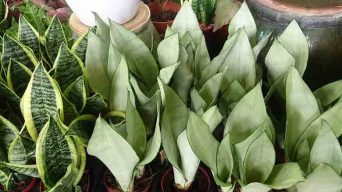Sansevieria Fernwood care is fairly easy if you know what you’re doing. However, there are a few things you’ll need to do in order to take good care of your plant.
Below, I have provided a guide on how to take care of and grow the Sansevieria Fernwood Mikado plant.
This includes information about watering guidelines, light requirements, temperature needs, soil preferences, fertilizing tips, and more!
About the Sansevieria Fernwood Mikado – Snake Plant
The Fernwood Mikado is a succulent plant of the genus Sansevieria originating from Africa. It is also known as “Fernwood” or “Snake Plant”.
The Fernwood is a popular houseplant because it tolerates low light and dry air. It also has an interesting snake-like pattern on the leaves, making them attractive to look at.
The Sansevieria Fernwood Mikado grows well in most world regions and is grown as pot plants for use indoors or outdoors.
This plant is a type of succulent, meaning it stores water in its leaves and has thick stems.
The Fernwood Mikado can grow up to four feet tall. However, they typically only reach about two feet because of the limited space indoors.
How To Care for Sansevieria Fernwood
Sun Exposure & Light Requirements
The Sansevieria Fernwood prefers bright indirect light. However, it does not do well in direct sunlight for extended periods.
Place the plant where it will be out of direct sun and away from drafts.
The Sansevieria Fernwood can withstand a little more sun once established but should generally receive as much light as possible to encourage new growth, coloration, and robustness.
If you like plants that need a lot of sun, put them near windows covered with curtains or blinds. This is so the plants won’t get too hot during the day while they still get enough light all day long.
A south-facing window is best for this type of placement.
If you live in an area with dreary winters, place your plants near a window that gets the most light during the winter months.
Consider supplementing natural light by using grow lights to ensure they get enough hours per day.
Sansevieria Fernwood plants are very adaptable and will do well in low-light conditions.
But if you want to keep it healthy and growing, ensure your plant gets at least ten hours of light per day.
Watering Your Sansevieria Fernwood
Sansevieria Fernwood plants are relatively drought-tolerant, so watering them often is unnecessary.
They should be watered about once every week or less. However, it is important not to over-water because it can cause root rot and make your succulent stop producing new foliage.
The best time of day for watering this succulent plant is in the evening hours.
Watering in the morning may lead to leaf scorch and sunburn damage due to over-exposure to sunlight during midday hours when temperatures reach their peak levels.
Soil
Sansevieria Fernwood is a succulent plant, meaning they need a well-drained soil.
Some people believe the best way to do this is by using a potting mix with plenty of perlite or vermiculite mixed in for drainage.
Others prefer using succulent-specific soil like Cacti and Succulents Mix.
It usually includes all the necessary nutrients for this type of plant.
Be sure to choose one that doesn’t have any fertilizer in it so your Fernwood won’t get too much nitrogen which can cause yellowing leaves or stunted growth.
Temperature and Humidity
The ideal temperature to grow Sansevieria Fernwood is between 65-90 degrees Fahrenheit.
This plant will need less water in higher temperatures, and in lower temperatures, it may require more water.
If you live in a warmer climate with high humidity (more than 40% relative humidity), the best thing for your fern leaf succulent is to provide bright indirect sunlight most of the day while keeping the soil moist but not wet or soggy.
However, if you live in colder climates with low humidity, then it should be kept at 75 F/23 C with average amounts of direct sunlight.
This means that they shouldn’t have much natural moisture from the air so that watering needs would be similar.
Fertilizing
Sansevieria Fernwood plants are not very demanding in terms of fertilizing. In fact, they are pretty sensitive to fertilizer.
This is why only organic fertilizers should be used for the best results.
Fertilizing can be done once every two months. Use liquid or granular plant food at half strength.
Do it in the spring and summer when plants grow and during the winter when plants are not growing much.
Potting and Repotting
When potting your Sansevieria Fernwood, make sure to use a soil mix with good drainage.
The pot should have drainage holes in the bottom so that excess moisture can escape from the root ball before being absorbed by your potting medium.
For this reason, clay pots are not ideal as they tend to hold on to too much water and nutrients, which could leave your plant with nutrient burn and dieback.
Clay containers may work if you make sure there are plenty of drain holes drilled near the base of each container.
When repotting your Fernwood, make sure to use a pot that is just slightly larger than the one it currently resides in.
When you transfer your Snake Plant into its new home, do so very carefully not to disturb the roots or break any of them off.
It’s also best to water both pots beforehand and let them absorb moisture before transferring your plant over for greater success.
If you have a big Sansevieria Fernwood plant that needs to be transplanted into something bigger, do it in early spring before the plant gets too much light or heat. This will make sure your plant isn’t sunburnt.
Pruning
It is important to prune your snake plant to keep it compact and bushy. This will allow the soil beneath the potting mix to dry out more quickly, preventing root rot from forming.
You should also be able to see that a healthy Sansevieria Fernwood has dense leaves without any brown edges or tips.
If this isn’t happening on your plants, you must trim off some dead leaves for new growth.
You’ll know when these old leaves are no longer getting enough light because they are usually drooping down toward the floor of the pot (or away from direct sunlight).
In order to prune a Sansevieria Fernwood, you’ll need to cut the leaves with shears or a sharp knife gently.
Make sure not to cut too far down towards the base of your plant because this can rot it if you hit any part of the stem with water on it.
Pests and Diseases
Pests and diseases can be common for any plant, but the Sansevieria Fernwood is especially vulnerable.
The most likely culprits are mealybugs, spider mites, or aphids. If left unchecked, they may damage the plants irreparably by sucking out their sap (phloem) which contains chlorophyll that allows photosynthesis to happen.
To control pests, you should have some insecticidal soap handy and neem oil available to spray them with immediately if they seem too numerous or persistent in their activity.
You can also try to change your watering habits and reduce the amount of water you give them, which may discourage pests.
Unlike other plants, the Sansevieria Fernwood is not susceptible to many bacterial or fungal diseases.
The most common disease is root rot, which is caused by overwatering or too much water sitting at the plant base.
The best solution to this problem is to remove any excess water that may be present and allow the soil to dry out a little before watering again.
Sansevieria Fernwood plants are resilient to most diseases and pests but may succumb to root rot.
How To Propagate Sansevieria Fernwood
The Fernwood variety of the snake plant is a beautiful succulent that will grow in most settings. It’s not too difficult to propagate these plants, but it does take time and patience.
If you want more Sansevieria Fernwood, then here are some tips on how to go about making them from scratch.
- This process is mainly done by taking cuttings or offshoots (stem sections) from healthy plants grown for at least one year.
- When propagating your Sansevierias yourself, be sure to choose mature and well-developed leaves as cutting material.
- Place the leaf cutting in a propagation pot with quality soil. The best medium is half succulent growing mix and half perlite.
- Keep the soil moist but not soaked.
- Place your pot in a bright location where it will get at least half a day of full sun exposure each week. The plant should show signs of growth within two weeks and root after six to eight months.
- Once rooted, transplant into an appropriate container with well-draining soil, keeping the cutting moderately dry until roots are established.
The process of propagating Sansevieria Fernwoods can take as long as two months, so be patient and don’t give up if you see no change at first!
The key is patience from start to finish.
Is the Sansevieria Fernwood Toxic?
The Sansevieria Fernwood is considered toxic to people or pets.
It can cause nausea, vomiting, and diarrhea in humans if ingested.
For this reason, you are not recommended to use the Sansevieria Fernwood as a houseplant if there are small children or pets in your home.
The toxic effects of this succulent plant are due to the sap that is found in its leaves.
It is, therefore, advisable not to ingest the plant material and wash hands thoroughly after handling.
Final Thoughts
Sansevieria Fernwood plants are great plants that make an excellent addition to any home.
They have many benefits, such as low maintenance and few diseases, making them an ideal house plant for beginners or even those who don’t have much time to care for their plants.







